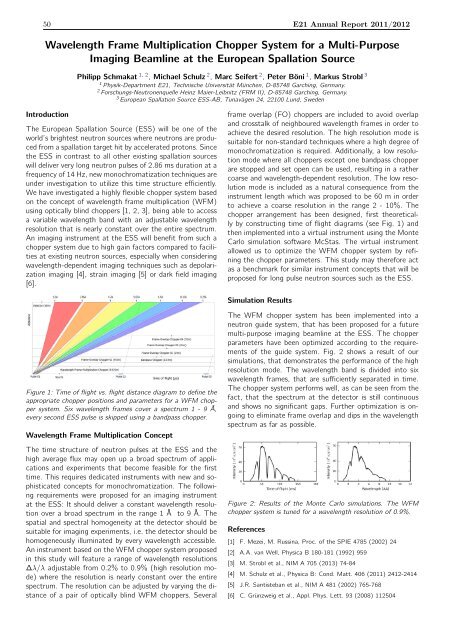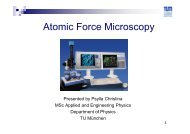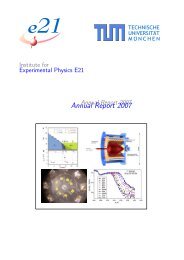Annual Report 2011 / 2012 - E21 - Technische Universität München
Annual Report 2011 / 2012 - E21 - Technische Universität München
Annual Report 2011 / 2012 - E21 - Technische Universität München
Create successful ePaper yourself
Turn your PDF publications into a flip-book with our unique Google optimized e-Paper software.
50 <strong>E21</strong> <strong>Annual</strong> <strong>Report</strong> <strong>2011</strong>/<strong>2012</strong><br />
Wavelength Frame Multiplication Chopper System for a Multi-Purpose<br />
Imaging Beamline at the European Spallation Source<br />
Philipp Schmakat 1, 2 , Michael Schulz 2 , Marc Seifert 2 , Peter Böni 1 , Markus Strobl 3<br />
1 Physik-Department <strong>E21</strong>, <strong>Technische</strong> Universität München, D-85748 Garching, Germany.<br />
2 Forschungs-Neutronenquelle Heinz Maier-Leibnitz (FRM II), D-85748 Garching, Germany.<br />
3 European Spallation Source ESS-AB, Tunavägen 24, 22100 Lund, Sweden<br />
Introduction<br />
The European Spallation Source (ESS) will be one of the<br />
world’s brightest neutron sources where neutrons are produced<br />
from a spallation target hit by accelerated protons. Since<br />
the ESS in contrast to all other existing spallation sources<br />
will deliver very long neutron pulses of 2.86 ms duration at a<br />
frequency of 14 Hz, new monochromatization techniques are<br />
under investigation to utilize this time structure efficiently.<br />
We have investigated a highly flexible chopper system based<br />
on the concept of wavelength frame multiplication (WFM)<br />
using optically blind choppers [1, 2, 3], being able to access<br />
a variable wavelength band with an adjustable wavelength<br />
resolution that is nearly constant over the entire spectrum.<br />
An imaging instrument at the ESS will benefit from such a<br />
chopper system due to high gain factors compared to facilities<br />
at existing neutron sources, especially when considering<br />
wavelength-dependent imaging techniques such as depolarization<br />
imaging [4], strain imaging [5] or dark field imaging<br />
[6].<br />
frame overlap (FO) choppers are included to avoid overlap<br />
and crosstalk of neighboured wavelength frames in order to<br />
achieve the desired resolution. The high resolution mode is<br />
suitable for non-standard techniques where a high degree of<br />
monochromatization is required. Additionally, a low resolution<br />
mode where all choppers except one bandpass chopper<br />
are stopped and set open can be used, resulting in a rather<br />
coarse and wavelength-dependent resolution. The low resolution<br />
mode is included as a natural consequence from the<br />
instrument length which was proposed to be 60 m in order<br />
to achieve a coarse resolution in the range 2 - 10%. The<br />
chopper arrangement has been designed, first theoretically<br />
by constructing time of flight diagrams (see Fig. 1) and<br />
then implemented into a virtual instrument using the Monte<br />
Carlo simulation software McStas. The virtual instrument<br />
allowed us to optimize the WFM chopper system by refining<br />
the chopper parameters. This study may therefore act<br />
as a benchmark for similar instrument concepts that will be<br />
proposed for long pulse neutron sources such as the ESS.<br />
Simulation Results<br />
Figure 1: Time of flight vs. flight distance diagram to define the<br />
appropriate chopper positions and parameters for a WFM chopper<br />
system. Six wavelength frames cover a spectrum 1 - 9 Å,<br />
every second ESS pulse is skipped using a bandpass chopper.<br />
Wavelength Frame Multiplication Concept<br />
The time structure of neutron pulses at the ESS and the<br />
high average flux may open up a broad spectrum of applications<br />
and experiments that become feasible for the first<br />
time. This requires dedicated instruments with new and sophisticated<br />
concepts for monochromatization. The following<br />
requirements were proposed for an imaging instrument<br />
at the ESS: It should deliver a constant wavelength resolution<br />
over a broad spectrum in the range 1 Å to 9 Å. The<br />
spatial and spectral homogeneity at the detector should be<br />
suitable for imaging experiments, i.e. the detector should be<br />
homogeneously illuminated by every wavelength accessible.<br />
An instrument based on the WFM chopper system proposed<br />
in this study will feature a range of wavelength resolutions<br />
∆λ/λ adjustable from 0.2% to 0.9% (high resolution mode)<br />
where the resolution is nearly constant over the entire<br />
spectrum. The resolution can be adjusted by varying the distance<br />
of a pair of optically blind WFM choppers. Several<br />
The WFM chopper system has been implemented into a<br />
neutron guide system, that has been proposed for a future<br />
multi-purpose imaging beamline at the ESS. The chopper<br />
parameters have been optimized according to the requirements<br />
of the guide system. Fig. 2 shows a result of our<br />
simulations, that demonstrates the performance of the high<br />
resolution mode. The wavelength band is divided into six<br />
wavelength frames, that are sufficiently separated in time.<br />
The chopper system performs well, as can be seen from the<br />
fact, that the spectrum at the detector is still continuous<br />
and shows no significant gaps. Further optimization is ongoing<br />
to eliminate frame overlap and dips in the wavelength<br />
spectrum as far as possible.<br />
Figure 2: Results of the Monte Carlo simulations. The WFM<br />
chopper system is tuned for a wavelength resolution of 0.9%.<br />
References<br />
[1] F. Mezei, M. Russina, Proc. of the SPIE 4785 (2002) 24<br />
[2] A.A. van Well, Physica B 180-181 (1992) 959<br />
[3] M. Strobl et al., NIM A 705 (2013) 74-84<br />
[4] M. Schulz et al., Physica B: Cond. Matt. 406 (<strong>2011</strong>) 2412-2414<br />
[5] J.R. Santisteban et al., NIM A 481 (2002) 765-768<br />
[6] C. Grünzweig et al., Appl. Phys. Lett. 93 (2008) 112504




